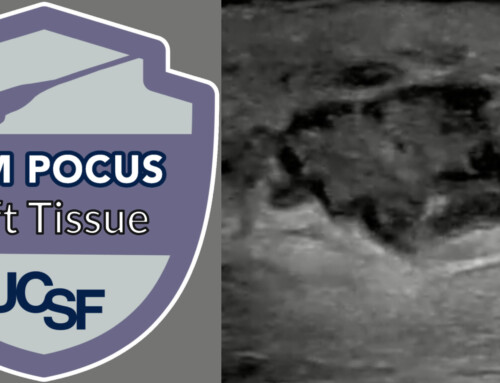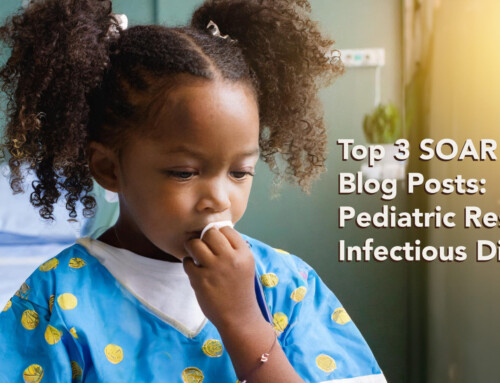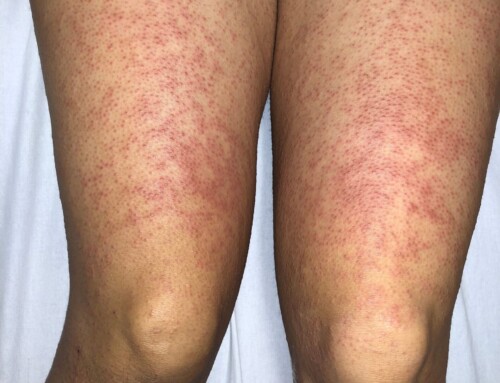
A thirty-one-year-old female presented to the emergency department with the complaint of a painful rash for 2 days. She has a history of HIV with a known CD4 count < 200 cells/µL. She states that the rash began two days ago and progressed to the current size. She describes the rash as burning and has never experienced these symptoms before. She has tried topical corticosteroids which did not alleviate the pain.
General: Alert and oriented to person, time, and place, no appreciable disease, ambulating and speaking in full sentences
Head: Extraocular movements intact, pupils equal, round, and reactive to light and accommodation, normocephalic, and atraumatic
Neck: Full range of motion, no lymphadenopathy
Cardiovascular: Regular rate and rhythm
Pulmonary: Clear to auscultation bilaterally, symmetric expansion
Gastrointestinal: Soft, non-tender, and non-distended
Skin: Grouped vesicles with an erythematous base present on the right side of neck and chest with no discernible dermatomal distribution. The rash does not cross the midline.
CD4 count: 120 cells/µL
All additional labs within normal limits
The photos demonstrate disseminated cutaneous herpes zoster in an immunocompromised patient. This rash is known as shingles and can be described as “dewdrops on a rose petal” due to its characteristic tiny fluid-filled vesicles seen in the images above.
Traditionally, shingles presents along a single dermatome in an immunocompetent patient as the virus remains latent in the dorsal root. This patient presented with a more severe rash. Even though the rash stayed on one side of the body, it encompassed multiple dermatomes indicating disseminated herpes zoster.
Herpes zoster is a rash that begins as erythematous papules and progresses to grouped vesicles. Eventually, the rash becomes pustular and will crust over in about a week.
Special consideration should be taken for immunocompromised hosts, as early skin lesions may progress to visceral involvement. For this reason, antiviral treatment should be initiated in immunocompromised patients regardless of the day of presentation.
For extensive cutaneous lesions in HIV-positive patients, a ten-to-fifteen microgram per kilogram dose of IV acyclovir every eight hours is the recommended treatment. A total of ten-to-fourteen days of therapy is advised.
Take Home Points
- Herpes Zoster rash begins as erythematous papules and progresses to grouped vesicles.
- Antiviral treatment should be initiated in immunocompromised patients regardless of rash onset.
- Gomez E, Chernev I. Disseminated cutaneous herpes zoster in an immunocompetent elderly patient. Infect Dis Rep. 2014;6(3):5513. Published 2014 Aug 26. PMID: 25276332
- Wood MJ, Kay R, Dworkin RH, Soong SJ, Whitley RJ. Oral acyclovir therapy accelerates pain resolution in patients with herpes zoster: a meta-analysis of placebo-controlled trials. Clin Infect Dis. 1996;22(2):341-347. PMID: 8838194
Copyright
Images and cases from the Society of Academic Emergency Medicine (SAEM) Clinical Images Exhibit at the 2020 SAEM Annual Meeting | Copyrighted by SAEM 2020 – all rights reserved. View other cases from this series on ALiEM.

Rykiel Levine, DO
NYC H+H/Lincoln Medical and Mental Health Center

Latest posts by Rykiel Levine, DO (see all)
- SAEM Clinical Image Series: Edema Got Your Tongue? - February 1, 2021
- SAEM Clinical Image Series: Severe Cutaneous Lesions in an Immunocompromised Host - August 17, 2020

Nicholas D. Caputo, MD
Associate Chief
Attending Physician
Department of Emergency Medicine
NYC H+H/Lincoln Medical and Mental Health Center
Associate Professor of Clinical Emergency Medicine Weill Medical College of Cornell University






